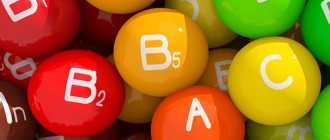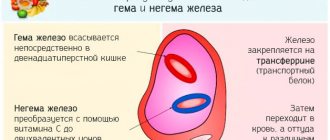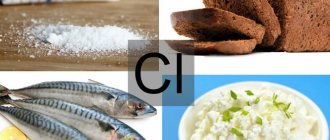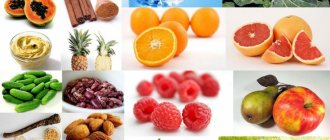Photo: Unsplash
It is difficult to find a more controversial topic than the benefits or harms of chicken eggs. Some people call chicken eggs a superfood, which is rich in much-needed micronutrients for the body. Other people call chicken eggs "a heart attack on a plate." You could say that chicken eggs are the Dr. Jekyll and Mr. Hyde of foods. There is probably no other food that causes such heated debate among scientists and ordinary people. It is difficult to sort through the variety of information and arguments. And of course, the main troublemaker is the egg yolk
, which contains huge amounts of cholesterol.
Even scientific research does not provide a comprehensive answer to the sacramental question. At the same time, chicken eggs are rich in important nutrients - choline, biotin, lutein, vitamin D, vitamin K2
, which are difficult to find in other foods. I decided to find out whether egg yolk is really so harmful to health?
Protein composition
Egg white is a viscous, colorless liquid that has no odor of its own. Its composition consists almost entirely of protein structures. For 100 g of chicken egg there is:
- 81.10 g protein;
- 7.80 g carbohydrates;
- 5.80 g water;
- 5.30 g minerals.
The protein part of chicken protein consists of ovalbumin, ovotransferrin, lysozyme, ovomucoid, ovomucin, which gives the protein its characteristic viscosity, and ovoglobulins G1 and G2.
Egg white also contains a large number of amino acids - tryptophan, threonine, isoleucine, leucine, lysine, methionine, cystine, phenylalanine, valine and others.
The mineral component includes selenium, sodium, potassium, magnesium, phosphorus, copper, calcium, iron and zinc.
The protein also contains cords - chalazae, which ensure the location of the yolk in the protein.
Conclusion
Egg yolk is a healthy product that supplies proteins, fats, carbohydrates, polyunsaturated fatty acids, vitamins A, E, B, D, K, PP, phosphorus, sodium, magnesium, potassium, calcium, selenium, manganese, zinc, copper, lecithin in human organism. It has a beneficial effect on vision, prevents the growth of cancer cells, brings vitality, supports heart function, nourishes nerve cells, improves the condition of skin, nails and hair.
The raw yolk is of greatest value to the human body, but it may contain parasites, so for safety reasons it is recommended to heat it. A soft-boiled egg contains an active anti-sclerotic substance – lecithin, which prevents the formation of harmful plaques.
Interestingly, the nutritional quality of the yolk is superior to fresh milk and fresh meat. Therefore, the product is recommended for daily use by all people who do not have allergies or gallstone disease. Otherwise, the positive effect of its use is completely neutralized, and pathological conditions that require medical intervention develop.
Sources
- Technical expert - GOST R 52121-2003 Chicken eggs for food. Specifications (with Amendment)
- Vostrikova S. M., Tretyakov M. Yu., Deineka V. I., Deineka L. A., Shaposhnikov A. A. – Carotenoids of poultry egg yolks // Scientific Bulletin of BelSU. Series Natural Sciences. – 2011 – No. 9 (104), Issue. 15/2. – pp. 219-226.
- Saifitova A. T., Vysotin S. A. – Features of eggs and egg products // International Student Scientific Bulletin. – 2020 No. 2. – P. 17-19.
More fresh and relevant information about health on our Telegram channel. Subscribe: https://t.me/foodandhealthru
Author of the article:
Izvozchikova Nina Vladislavovna
Specialty: infectious disease specialist, gastroenterologist, pulmonologist.
Total experience: 35 years.
Education: 1975-1982, 1st MMI, San-Gig, highest qualification, infectious disease doctor.
Scientific degree: doctor of the highest category, candidate of medical sciences.
Training:
- Infectious diseases.
- Parasitic diseases.
- Emergency conditions.
- HIV.
Yolk composition
The yolk is the main part of the egg, the nutrient medium for the chicken embryo. Its composition is extremely important, since the developing chicken does not have the opportunity to obtain the necessary substances from the outside. For 100 g of yolk there are:
- 59.13 g fat;
- 33.63 g protein;
- 0.66 g carbohydrates;
- 3.08 g water;
- 3.51 g minerals.
This composition provides the embryo with all the necessary substances for harmonious development.
Chicken egg shell
The shell is an equally important part of a chicken egg. Too soft will not provide the future embryo with adequate protection, and too hard will not allow the chicken to hatch. Eggshells contain a large amount of minerals that ensure their strength.
Structure
The shell has an outer porous shell through which air enters the developing embryo. Underneath it is an internal shell membrane that allows air to pass through freely. After the egg is laid, an air chamber is formed in it.
The shell consists of two layers - the inner one, which has a crystalline structure, and the outer spongy one, permeated with pores and tightly connected to the inner one. On the surface of the spongy layer there is a cuticle, or a film consisting of mucin fibers. The cuticle dissolves only in hot water, is permeable to gases and serves to protect the shell from microorganisms.
The shell under the shell
The protein is covered by two subshell membranes formed by a network of intertwined organic fibers. They are the ones who determine the future shape of the shell. The outer subshell membrane is connected to the inner layer of the shell using mammillary tubercles. The inner shell is lined with a thin film. After the egg is laid, an air chamber is formed between the shell membranes.
Air chamber
Formed after an egg has been laid. Its formation is based on the fact that the contents of the egg cool and shrink faster than the shell itself. In most cases, it is located in the center of the obtuse pole of the egg, less often it is shifted to the side or is outside the normal location zone. The diameter of the air chamber ranges from 15 to 18 mm, and during long-term storage of the egg it increases.
Chemical composition of the shell
The shell consists mainly of minerals - about 95%. The main substance is calcium carbonate (93% of the total mass). Magnesium carbonate accounts for 1.5%, alkaline earth phosphates about 1%.
The total chemical composition includes:
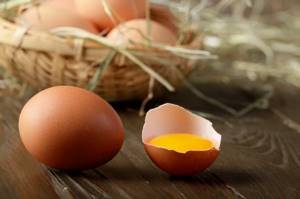
In biology, a chicken egg is a female reproductive cell, an egg. It is formed in the ovary and oviduct, in which it is covered with shell membranes.
Quail egg
Nutritionists and ordinary people like to talk about the benefits and harms of raw and boiled eggs. But so far we have talked about the product that domestic chickens provide us. However, today quail eggs have become very popular. This is not without reason, as many researchers call them a “health capsule.”
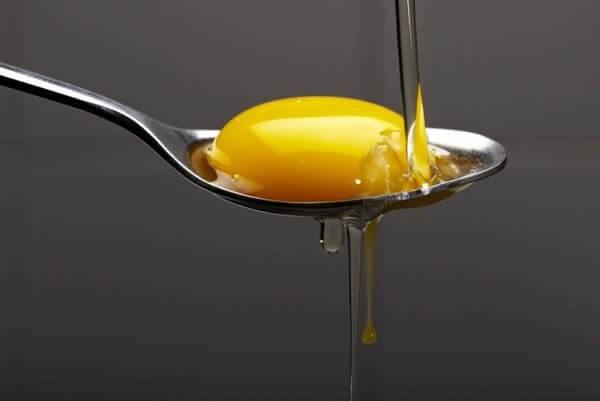
Despite the fact that quail eggs are much smaller than chicken eggs, they contain five times more potassium, 4 times more iron and approximately two times more cobalt, calcium, copper and phosphorus. As for the content of minerals, vitamins and amino acids, we note that there is also a significant difference here. There are many times more vitamins B, A, PP and essential amino acids in a quail egg.
It is difficult to consider them simply as a food product. There is probably no person who does not know how good boiled quail eggs are. The benefits of their regular use are enormous. They stimulate the immune system and normalize the activity of both the gastrointestinal tract and the cardiovascular system. Many men prefer to eat this product for breakfast, as it has a positive effect on potency and removes radionuclides from the body well.
In addition, positive changes with regular use are noted by people suffering from anemia, hypertension, diabetes, bronchopulmonary diseases and nervous system disorders. Judging by the latest data, quail eggs are completely hypoallergenic, which cannot be said about chicken eggs. That is why they are recommended for young children, who are most likely to have an allergic reaction to egg white.
Protein composition
Egg white is a viscous, colorless liquid that has no odor of its own. Its composition consists almost entirely of protein structures. For 100 g of chicken egg there is:
- 81.10 g protein;
- 7.80 g carbohydrates;
- 5.80 g water;
- 5.30 g minerals.
The protein part of chicken protein consists of ovalbumin, ovotransferrin, lysozyme, ovomucoid, ovomucin, which gives the protein its characteristic viscosity, and ovoglobulins G1 and G2.
Egg white also contains a large number of amino acids - tryptophan, threonine, isoleucine, leucine, lysine, methionine, cystine, phenylalanine, valine and others.
The mineral component includes selenium, sodium, potassium, magnesium, phosphorus, copper, calcium, iron and zinc.
The protein also contains cords - chalazae, which ensure the location of the yolk in the protein.
Yolk composition
The yolk is the main part of the egg, the nutrient medium for the chicken embryo. Its composition is extremely important, since the developing chicken does not have the opportunity to obtain the necessary substances from the outside. For 100 g of yolk there are:
- 59.13 g fat;
- 33.63 g protein;
- 0.66 g carbohydrates;
- 3.08 g water;
- 3.51 g minerals.
This composition provides the embryo with all the necessary substances for harmonious development.
Chicken egg shell
The shell is an equally important part of a chicken egg. Too soft will not provide the future embryo with adequate protection, and too hard will not allow the chicken to hatch. Eggshells contain a large amount of minerals that ensure their strength.
Structure
The shell has an outer porous shell through which air enters the developing embryo. Underneath it is an internal shell membrane that allows air to pass through freely. After the egg is laid, an air chamber is formed in it.
The shell consists of two layers - the inner one, which has a crystalline structure, and the outer spongy one, permeated with pores and tightly connected to the inner one. On the surface of the spongy layer there is a cuticle, or a film consisting of mucin fibers. The cuticle dissolves only in hot water, is permeable to gases and serves to protect the shell from microorganisms.
Beneficial features
A bird's egg is a supplier of proteins, fats, carbohydrates, vitamins, phospholipids, macro- and microelements necessary to nourish the embryo. At home and farmsteads, the laurels of primacy belong to ducks, geese, quails and chickens. Each type has its pros and cons.
In terms of carbohydrate content, the leaders among birds are geese and ducks (1.2%). Second place belongs to chickens - 1%. In quail eggs this indicator is completely absent. At the same time, the amount of cholesterol in their yolk is 13% higher than that of other birds. However, it is balanced by phospholipids, choline, and lecithin, which are necessary to nourish nerve cells.
The smaller the egg, the higher the cholesterol concentration. Thus, in the yolk of quail this indicator reaches 0.4 mmol/l, in geese – 0.25 mmol/l, in chickens and ducks – 0.11 mmol/l. Poultry eggs increase the body's defenses, prevent bile stagnation, normalize digestion, strengthen bones, improve memory and prevent the occurrence of vitamin deficiency. The goose product has the greatest nutritional value (202 kcal) due to the abundance of fat (13%) in the composition. Second and third places are shared by chicken (162 kcal) and quail (158 kcal) eggs, which is why they are considered dietary and allowed for consumption in the process of losing weight.
The yolk of duck eggs helps strengthen teeth and bones, while goose eggs improve vision and prevent the appearance of cataracts. Chicken and quail have a balanced mineral composition, maximum digestibility, and replenish the deficiency of phosphorus, potassium, and iron in the body, which is especially important for people suffering from low hemoglobin and problems with the musculoskeletal system.
Regardless of the type, all eggs are strong allergens, so they should not be abused. In addition, salmonella bacteria may be present in the raw product. To avoid contracting an infectious disease, the yolk, like the white, is not recommended to be consumed fresh. It should be heat treated.
Despite the variety of choices, only chicken product is suitable for the daily diet. The yolk of other bird species is allowed to be consumed, but not on an ongoing basis.
Harm and contraindications
In general, there are no special contraindications to eating yolk, but there are some precautions for people with individual intolerance:
- Those who suffer from extra pounds should use the product with caution, as this component can cause an increase in blood cholesterol levels .
- The next danger that may lie in wait is salmonella . This parasite is bacteria, which in turn can cause salmonellosis. This is an infectious disease that affects internal organs and can be severe. Therefore, before eating, eggs must be processed, and in order to protect yourself from infection, you should not eat raw yolks.
- To avoid negative consequences, it is recommended that men consume no more than 4 yolks , and women - no more than 2.
- Those who have heart problems should not eat the yolk, as in this case the product can actually cause harm to the body.
Thus, contraindications exist only for those people who have their own individual characteristics. In addition, you should not eat yolk excessively, as it is very high in calories and can harm a beautiful figure.
Chemical composition
Egg yolk is a source of vitamin E, which supports the health of human reproductive organs. As an antioxidant, it fights cancer cells by destroying free radicals. Its effectiveness in improving the condition of hair, nails and skin has been noted. The yolk is of particular value for pregnant women, as it reduces the likelihood of developmental defects in the fetus.
Currently, there is an opinion that cholesterol concentrated in eggs poses a danger to human health. Indeed, yolks contain saturated fats that are unhealthy for the body. However, they are balanced by valuable polyunsaturated ones, which normalize lipid metabolism, regulate vascular tone, prevent metabolic and cardiovascular disorders, ensure the synthesis of anti-inflammatory prostaglandins, and improve microcirculation.
Egg yolk delays the rapid passage of food through the stomach into the intestines. Due to this, the accumulation of glucose slows down, little insulin is produced, and less subcutaneous fat is formed.
The weight of one egg depends on the type of bird and is:
The yolk accounts for a third of the egg's mass. The uniqueness of the yellow fraction of the product lies in the content of an active anti-sclerotic agent - lecithin, which nourishes nervous and brain tissue. In addition, the substance is necessary for the proper functioning of the biliary tract and liver, regulation of the distribution of adipose tissue.
Nutritional value of raw egg yolk
| Components | Content per 100 g of product, g |
| Water | 52,31 |
| Fat (g) | 26,5 |
| Proteins (g) | 15,9 |
| Monounsaturated fatty acids | 11,738 |
| Saturated fatty acids | 9,551 |
| Essential amino acids | 7,869 |
| Nonessential amino acids | 7,758 |
| Polyunsaturated fatty acids | 4,204 |
| Omega-6 | 3,976 |
| Carbohydrates (g) | 3,6 |
| Ash | 1,71 |
| Sterols | 1,085 |
| Mono- and disaccharides | 0,56 |
| Omega-3 | 0,228 |
Composition of chicken yolk and protein
Chicken yolk composition:
- Omega-3 and omega-6 acids. That is why some vegetarians who do not eat meat and fish introduce large amounts of eggs into their diet. After all, consuming 4 yolks can completely cover the body’s consumption and need for these acids.
- The yolk contains a lot of fat-soluble vitamins, such as B vitamins. These are B1, B12, B6. All these components have a positive effect on the condition of the skin and strengthen the walls of blood vessels.
- However, if they are taken without accompanying substances, they are poorly absorbed in the body, since they are fat-soluble. That is why consuming yolk is an ideal option that will facilitate the absorption of beneficial vitamins.
Chicken protein composition:
- The vitamins contained in protein are presented on their own, that is, without fat. They are the same as in the yolk: B1, B12, B6.
- Accordingly, the absence of omega acids in protein means that beneficial elements will be washed out of the body, and those that come with food will not be absorbed.
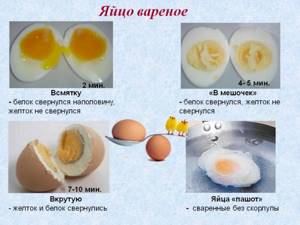
Options for cooking eggs
Harmful properties
Despite the high biological value, the product is not recommended to be abused. The safe daily intake is 2 yolks for women and 4 for men. In this case, they will enrich the body with useful components without causing harm to health. If you exceed these indicators, the risk of weight gain and obesity increases.
Remember, yolks contain a lot of fat and cholesterol, an excess of which can lead to problems with the cardiovascular system. In addition, eggs can be contaminated with a dangerous microbe - salmonella, which causes an acute infectious disease. This condition is accompanied by disruption of the gastrointestinal tract and blood circulation, which causes cold hands and feet, decreased blood pressure, increased body temperature, intense vomiting, and loose, watery stools up to 10-20 times a day. Diarrhea leads to dehydration.
In case of loss of 10% of the moisture contained in tissues and organs, hypovolemic shock develops. With a further increase in this indicator and reaching the 20% mark, irreversible processes occur and the patient dies. If left untreated, salmonellosis causes severe complications: it disrupts the functioning of the kidneys and heart muscle, causes vascular collapse, and provokes the progression of purulent pathologies such as peritonitis and abscess.
For people with cholelithiasis, yolk is contraindicated because it can cause spasms, colic, and exacerbation of the disease. In addition, eggs should be excluded from the diet of allergy sufferers, since the protein contains aggressive components - ovalbumin and ovomucoid, which are not destroyed even during heat treatment.
It is believed that quail product is safer than chicken product, but this is a myth. Partridge eggs also contain ovomucoid.
Interestingly, allergies to yolk are much less common than to whites, since the yellow fraction allergen is neutralized under the influence of high temperatures.
Egg yolk: benefits and harms
When it comes to cholesterol, many doctors, in addition to fatty foods, draw our attention to egg yolks. The yolks actually contain about 200 mg of cholesterol, but it is easily leveled out by the lecithin contained in the same eggs.
It is also necessary to understand that when there is a lack of calcium in the body, cholesterol begins to, as it were, replace it. So if your blood vessels have very thin walls, then this good (healthy) cholesterol tries to protect them. The main problem with egg yolk is its consumption in excess. Now let's talk about everything in order.
Benefits of egg yolk
Egg yolks are a source of a huge amount of nutrients, vitamins and minerals (80% of a whole egg). Therefore, if you separate the white from the yolk and consume the white alone, you are depriving yourself of the following:
- Unsaturated fatty acids (Omega-3)
- Vitamin B12
- Vitamins A, E, D
- Selenium
- Iron
- Potassium
- Biotin (Vitamin H)
- Choline (a substance from the B vitamin group)
- Beta carotene
- Phosphorus
- Squirrels
Despite this, many experts argue that by consuming egg yolks, you are risking your health, hinting at the presence of cholesterol in them. But if you look at the composition of the yolk indicated above, it becomes clear that these substances (mostly B vitamins) have the properties to effectively regulate the level of good cholesterol.
Egg yolk damage
Despite the obvious benefits, the disadvantages of yolk are cholesterol and fats. Therefore, this product is not recommended for abuse by people with various cardiovascular diseases and obesity. In fact, the real thing to be wary of is saturated and trans fats (fatty pork, palm oil, margarine, etc.), not egg yolk.
Raw, boiled or fried yolk
A raw egg
Eggs are much easier and faster to consume raw. But for many this is not entirely pleasant. By the way, a raw egg is only half absorbed by the body. In addition, eggs may contain harmful bacteria - salmonella. If the egg is not thermally treated, then the chances of poisoning will be much greater.
Note: “There is no salmonella in raw quail eggs.”
Fried egg
Fried egg (scrambled egg) is one of my favorite dishes. What could be easier than cooking scrambled eggs? Unfortunately, with this type of heat treatment, almost all beneficial substances are destroyed and trans fats are released. But still, absorption by the body occurs much better than a raw egg.
Boiled egg
When boiled, an egg is 98% digestible, retains most of its nutrients and has no traces of fat after cooking. In my opinion, the choice of a healthy cooking method for consuming eggs is obvious.
Egg quality and quantity
Currently, there is a wide selection of different egg producers on store shelves, but not all can boast of excellent quality. The yolks should be bright orange and have a strong shell, but I rarely see such, and the chickens are raised in an unknown way. In this regard, farm eggs have more advantages over factory eggs.
The amount of yolk and eggs consumed in general should be such that cholesterol and fats do not exceed the norm. About 6 eggs per week for an adult will be enough. To increase muscle mass, athletes consume 3-4 times more (almost without yolks), but their physical activity is different.
That's all for today. I hope you have emphasized for yourself the benefits and harms of egg yolks.
Source https://bodykeeper.ru/yaichnyj-zheltok-polza-i-vred/
Egg yolk contains vitamin B6, folic acid, vitamins B, B-12, A, D, E and K. This food is also rich in calcium, iron, potassium, sodium, magnesium and selenium. Interestingly, 90 percent of the calcium contained in the entire egg is found in the yolk, and 93 percent of the iron is also found in this part of the egg.
Yolk and eye health
This product contains lutein, carotenoids and zeaxanthin, which have a beneficial effect on vision. It is these substances that give the yolk its yellow color. Carotenoids may reduce the risk of macular degeneration associated with age-related changes and cataracts. These substances are also powerful antioxidants, meaning they can protect the human eye from free radicals, which can often cause the eyes to be unable to focus color correctly.
The effect of phosphorus and zinc on human health
The vitamins and minerals contained in yolks can prevent cardiovascular diseases. 100 grams of this product contains 590 mg. phosphorus, which improves the condition of bones and teeth. This mineral develops physical endurance and improves brain function. Phosphorus also helps withstand high athletic stress. High iron content helps prevent diseases such as iron deficiency anemia. Yolks are recommended for people involved in strength sports, as this product contains many nutrients. The zinc contained in this product has a beneficial effect on the processes of puberty and growth, this trace element is also useful for the immune system, wound healing, it helps absorb proteins, prevents fatigue and is involved in the transport of vitamin A in the retina.
Egg yolk and vitamins
Egg yolk has a positive effect on the health of the skin and mucous membranes. Vitamin B7 contained in this product is beneficial for hair. Folic acid is necessary for the female body during pregnancy and breastfeeding. Yolks are also useful for pregnant women because they contain choline, which promotes the development of the nervous system in the fetus. This product also replenishes folic acid deficiency, which can be caused by smoking, taking medications and drinking alcohol. Yolks are rich in vitamin B7, which can stabilize blood sugar levels.
Lecithin
Lecithin improves the condition of the liver and gall bladder. This substance plays a significant role in the prevention of heart disease and also helps in weight loss. Research conducted in 1985 proved that lecithin helps prevent Alzheimer's disease and improves memory processes. This substance is also effective against fatty liver (steatosis), as it improves fat metabolism and prevents the accumulation of excess fat in the body. Lecithin also has a beneficial effect on the hair structure and gives it shine, which is why this ingredient is used in the manufacture of shampoos. This substance quickly restores dry and split ends. Due to the moisturizing properties of yolks, they are present in many recipes for cosmetic masks.
Harm of egg yolks
In recent years, many nutritionists have not recommended eating chicken eggs, as they contribute to high cholesterol levels in the blood. According to the latest research, moderate consumption of eggs has beneficial effects on health due to their high content of nutrients and vitamins. Cholesterol levels are greatly increased by consuming saturated fats found in cheese, yogurt, milk, fatty meats, as well as trans fats found in sweets such as cakes, pastries, and cookies. Trans fats are found in margarine and hydrogenated vegetable oils. According to numerous studies, eating eggs one or two days a week does not increase the risk of vascular and cardiac diseases.
In some cases, allergic reactions occur. They usually appear immediately or a couple of hours after eating egg dishes. Symptoms may include hives, diarrhea, nausea, itching, sneezing, and coughing. Severe allergic reactions are rare and can cause difficulty breathing and low blood pressure, leading to dizziness or even loss of consciousness. It is not recommended to eat raw eggs, as they may contain pathogenic bacteria. Salmonella pathogens can be found both inside the egg and on the shell, so it is advisable to wash and heat treat these products. If you have cholecystitis, you should consult your doctor, as an abundance of yolks in the diet can cause an exacerbation. People with heart disease should not overuse egg dishes.
Source https://healthislife.ru/yaichnye-zheltki-polza-i-vred.html
Eggs in bodybuilding
Professional athletes carefully monitor their diet because they know how important proper nutrition is to obtain the desired result. The main goal of athletes is to build muscle mass. To complete the task, you need to adhere to the established training regimen, replenish the deficiency of nutrients after exercise, focus on protein foods or all kinds of supplements: gainers, proteins. However, adherents of a healthy diet always insist that the human body absorbs nutrients better from natural products than from synthetically produced chemical cocktails.
Eggs are considered the most affordable source of high-quality, easily digestible protein, which contains essential amino acids necessary for muscle growth. However, is there any benefit from yolk for athletes? Yes. When building muscle mass, it is no less valuable than protein. Firstly, it also contains amino acids. Secondly, the yolk improves protein absorption.
Secrets of a simple egg
Thanks to this product, you can quickly restore strength and strengthen the immune system, since egg white is used to build your own antibodies. Eggs are an indispensable product for athletes, as they allow you to quickly build muscle mass, even with intensive weight loss, by reducing the volume of adipose tissue.
So far we have been talking about the benefits of protein, completely bypassing the unique yolk. This is a truly magical cocktail that contains biologically active substances such as lutein, choline, lecithin, biotin and many others. Egg yolk is a source of essential fat-soluble vitamins A, D, E, group B.
During a period of active growth and recovery after a serious illness, you can’t think of anything more necessary than a boiled egg. The benefits of this product are indescribable. Add to all of the above minerals - phosphorus and zinc, sulfur, calcium, potassium, magnesium, manganese and iron - and you will get an invaluable supply of nutrients for the nervous system and cerebral cortex.
We suggest that you familiarize yourself with Honey on an empty stomach: useful
What is the correct form to eat eggs in?
The raw product may contain a harmful microorganism, salmonella, so it must be boiled first. In this case, the egg must be soft-boiled (the state when the yolk remains liquid). This way, maximum nutrients are retained and lecithin is not destroyed.
Remember, one chicken yolk contains up to 5 g of fat, so during the “drying” process, athletes need to stop consuming the product.
Methods for separation from protein
The easiest method for separating the components of a raw egg is using a special pear. To do this, just take a plate and carefully break the product. After this, the pear is squeezed, releasing as much air as possible from it, its neck is brought to the yolk, ensuring their contact, and the fingers are slowly unclenched. The device will instantly “suck in” the yellow fraction.
Other ways to separate egg yolk:
- Make small holes on both ends of the shell. Place your lips on one of the resulting holes and blow out the protein.
- Break the shell down the middle of the egg on one side using a knife, slightly separate the halves, and transfer the yolk from one part to the other over a plate. During these manipulations, most of the protein will pour into the container.
- Make a funnel out of paper like for seeds, put it in a glass. Then crack the egg directly into it. Through a small hole in the funnel, the white will flow into the glass, and the yolk will remain in the paper bag.
Folk remedy for psoriasis - recipe with egg yolks
There is an old folk recipe for treating psoriasis with an ointment made from fresh egg yolks and birch tar. For 150 g of tar, take 5 g of camphor oil, 3 yolks and 150 g of pure alcohol. The yolks are ground with oil in a metal bowl, then combined with tar and mixed. Alcohol is added to the mixture last. Store the product in a dark place. The affected areas are lubricated with a cotton swab and then try to protect these areas of the skin from contact with water for 24 hours. After 24 hours, you can wash off the ointment with warm water and soap. Over the next 24 hours, the skin “rests,” and then all operations are repeated again. According to this algorithm, treatment is carried out until the result is achieved.
Protecting hair health
Egg yolk is a storehouse of useful nutrients that strengthen and restore the structure of hair strands, stimulate their growth, get rid of dandruff, and prevent hair loss. Masks and shampoos based on it refresh and tone hair, making it elastic, smooth and shiny.
For cosmetic purposes, use the yolk of fresh eggs, preferably homemade. It is suitable for nourishing all hair types. However, keep in mind that the product dries quickly in the air, so it will take time to wash it off your hair. In addition, the yolk has a characteristic odor that can be easily removed after rinsing the hair with water.
When using egg masks, it is recommended to cover your head with polyethylene; this will slow down their drying and simplify the rinsing procedure.
To achieve a lasting, noticeable result, hair treatments using yolk are recommended to be carried out at least 2-3 times a week. Shampoo and masks are applied to damp hair with light movements, gently massaging the scalp. The medicinal composition is left for 3 – 15 minutes, after which it is washed off. To restore natural strength and shine, curls are rinsed with an acidified composition no more than 2 times every 7 days. To do this, add 15 ml of lemon juice or apple cider vinegar to 1000 ml of water. Excess moisture is removed with a cotton towel and dried naturally. Under no circumstances should you use a hairdryer after the procedure. Hot air can damage your hair, making it dry and brittle.
- Shampoo for strengthening hair. Ingredients: 10 ml purified water, 2 egg yolks, 3 drops of pine essential oil.
- Composition for moisturizing and nourishing dry, weakened hair. Ingredients: 5 ml beer, 1 egg yolk, 15 ml baby shampoo.
- Hair loss remedy. Components of the medicinal mixture: 60 ml carrot juice, 1 egg yolk, 15 ml lemon juice, 15 ml vegetable oil.
- Nourishing mask. Ingredients: avocado pulp puree, 1 egg yolk.
- Mask for hair growth. Ingredients: 15 ml burdock oil, 5 ml cognac, 2 egg yolks, 15 ml castor oil, 30 ml honey, 20 g yeast. The prepared mass is placed in a water bath, after the composition becomes warm, it is distributed from the roots to the ends of the hair. The head is insulated with a plastic bag and a terry towel. Unlike previous products, the mask is kept for 1.5 hours, after which it is washed off with warm water.
In addition to hair care, yolk is used in the cosmetics industry to nourish and moisturize dry dermis. In this case, the combination of the yellow fraction of the egg with olive oil is considered a win-win option, ensuring maximum absorption of nutrients and moisturizing the skin. To improve skin tone, the yolk is mixed with fruit or vegetable puree.
Those with dry skin should never use formulations with citrus fruits containing aggressive acids, as they intensely tighten pores, cause irritation, and aggravate the existing problem.
